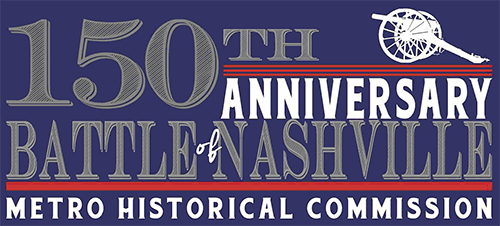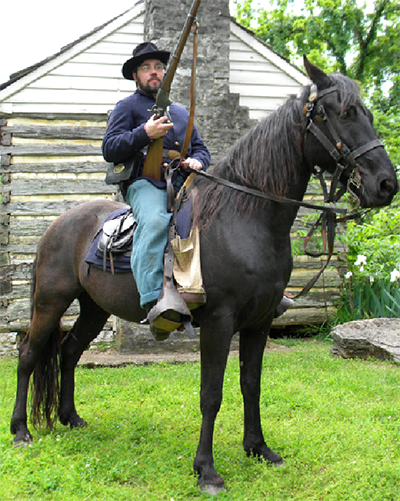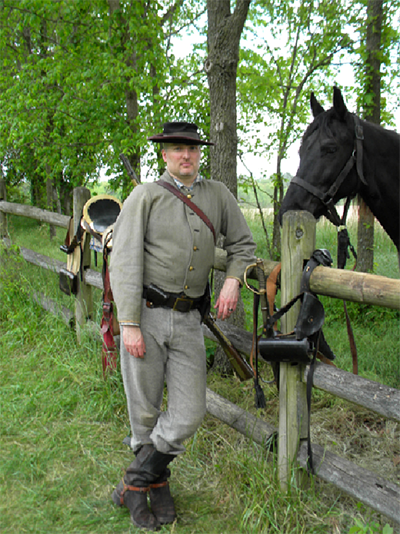150th Anniversary of the Battle of Nashville

Nashville Historic Sites Commemorate the 150th Anniversary
of the Battle of Nashville on December 13, 2014
The Battle of Nashville was o ne of the most decisive conflicts of the Civil War. Multiple Nashville and Middle Tennessee historical groups are hard at work coordinating events to commemorate the 150th anniversary of the Battle of Nashville, which was fought in Nashville on December 15-16, 1864. Calendars should be marked for Saturday, December 13, 2014, for the multi-site, city-wide, all-day program.
ne of the most decisive conflicts of the Civil War. Multiple Nashville and Middle Tennessee historical groups are hard at work coordinating events to commemorate the 150th anniversary of the Battle of Nashville, which was fought in Nashville on December 15-16, 1864. Calendars should be marked for Saturday, December 13, 2014, for the multi-site, city-wide, all-day program.
Ten Civil War historic sites in the Nashville areawill host living history demonstrations with Confederate and Union reenactors and cannon firings. Several locations are organizing special exhibitions and events to mark the sesquicentennial anniversary of this important battle.
“This December marks 150 years since war struck the heart of our city,” said Nashville Mayor Karl Dean. “This anniversary provides us with an occasion to showcase Nashville’s important historic sites for our residents and visitors who may not be familiar with the rich Civil War history we have here. I am proud to see so many people working together to commemorate and interpret an important time in our nation’s history. This special programming will provide educational opportunities for all.”
With Living History Events:
Belle Meade Mansion: As the headquarters for Confederate General Chalmers, who commanded a portion of Forrest’s cavalry, Belle Meade Mansion played an important role in the Battle of Nashville. Belle Meade experienced a cavalry battle between Chalmer’s men and the Union Cavalry on December 15, 1864. Living history interpreters will provide programs on both the Union and Confederate cavalry on the grounds of Belle Meade. The site will also feature an artillery demonstration. 5025 Harding Pike.
Belmont Mansion: Headquarters of Union General Thomas J. Wood and his staff, who used Belmont Mansion’s cupola to observe the Battle of Nashville. Living history interpreters depicting the staff of General Wood will be on hand to discuss the role of Belmont in the battle. Several rooms in the house will also be set up to reflect the presence of the Union soldiers. 1700 Acklen Ave.
Bicentennial Mall State Park: Nashville became not only a major supply center and transportation hub for the Union Army, but also a destination for thousands of refugees, both white and black, who were displaced by the war. Join civilian living history interpreters as they relate the stories of survival in the midst of a war that impacted thousands of civilians. The visitor’s center at the Bicentennial Mall also features an exhibit on the Civil War in Tennessee. 600 James Robertson Pkwy.
Fort Negley: The largest of the Union fortifications built to defend Nashville, Fort Negley was built by former slaves hired by the army. The living history programs at Fort Negley will include Union artillery and infantry demonstrations as well as the US Signal Corps and United States Colored Troops. 1100 Fort Negley Blvd.
The Land Trust for Tennessee’s Glen Leven Farm: Situated between the main Union and Confederate lines, The Land Trust for Tennessee’s Glen Leven Farm was within cannon shot of Fort Negley. Union troops, including an entire division of United States Colored Troops, marched across the farm as they attacked the Confederate lines on December 16, 1864. The home was used as a Union hospital in the immediate aftermath of the fighting. Visitors to Glen Leven can interact with interpreters portraying Union surgeons to learn about typical Civil War medical practices. An exhibit on Glen Leven during the Civil War will also be available for viewing. 4000 Franklin Pike.
Redoubt No. 1: In an effort to besiege the Union Army in Nashville, the Confederates built a series of earthworks covering the southern approaches to the city. These works included a number of strong points with artillery called redoubts. The redoubts were overrun by the attacking Union troops on December 15, 1864. A small group of Union soldiers will interpret their actions as they stand guard over Confederate prisoners captured during the first day of battle. Benham Avenue, Green Hills.
Shy’s Hill: The Confederate entrenchments atop Shy’s Hill were assaulted by Union troops on December 16, 1864. The Confederate defenders found themselves fighting a three front battle as Union cavalry got behind their positions and destroyed the left end of the Confederate line. Join Confederate and Union infantry soldiers as they tell the story of attacking and defending this crucial point of the Confederate line. Benton Smith Rd.
Travellers Rest: As the headquarters of General John Bell Hood, the overall commander of Confederate forces, Travellers Rest served a pivotal role in the Battle of Nashville. The site will recreate the look and feel of the “nerve center” of an army on active campaign. Living history volunteers will depict couriers on horseback, staff officers carrying out the operations of an army, and an infantry squad serving as headquarters guard. The headquarters functioned in the midst of the Overton family who still resided in the house. The interaction between soldiers and civilians will be depicted as well as Confederate artillery and typical music of the common soldier. Visitors may also visit the exhibition on the Civil War at Travellers Rest. 636 Farrell Pkwy.
Tennessee State Library and Archives: Visit the Tennessee State Library and Archives temporary exhibit on the year 1864. On view in the lobby, this exhibit will discuss this crucial year of the war that culminates with the destruction of the Confederate army at Nashville. The exhibit also includes information on how to trace your Civil War ancestor. 403 7th Ave., North
Tennessee State Museum: A temporary exhibit will be on view wherevisitors will learn about the lives of civilians during military occupation, many challenges confronting women on the home front, and the soldiers who fought in the battle. A cyclorama study of the Battle of Nashville will also be on display. The exhibit also examines how many African Americans freed themselves during the war and how the state officially ended slavery. In the museum’s permanent exhibits, the Civil War holdings of uniforms, battle flags and weapons are among the finest in the nation. 505 Deaderick Street. 615-741-2692
There is no admission fee for the exhibits and events for the following locations: Fort Negley, Bicentennial Mall State Park, Redoubt No. 1, Shy’s Hill, Tennessee State Library & Archives and the Tennessee State Museum.
A special $30 ticket will be available for admission and for events taking place at the following locations: Belmont Mansion, The Land Trust for Tennessee’s Glen Leven Farm, and Travellers Rest. Tickets can be purchased at these locations or online at www.bonps.org.
The city-wide commemoration for the Battle of Nashville will begin at 10 a.m. on Saturday, Dec. 13 and conclude at sunset as cannons will be fired at the various historic sites participating in the commemoration.
At 4:30 p.m. on Tuesday, Dec. 16, the actual anniversary date of the battle, Nashville churches and schools around all parts of the city will toll their bells to commemorate this historic event.
.png)
|
|


